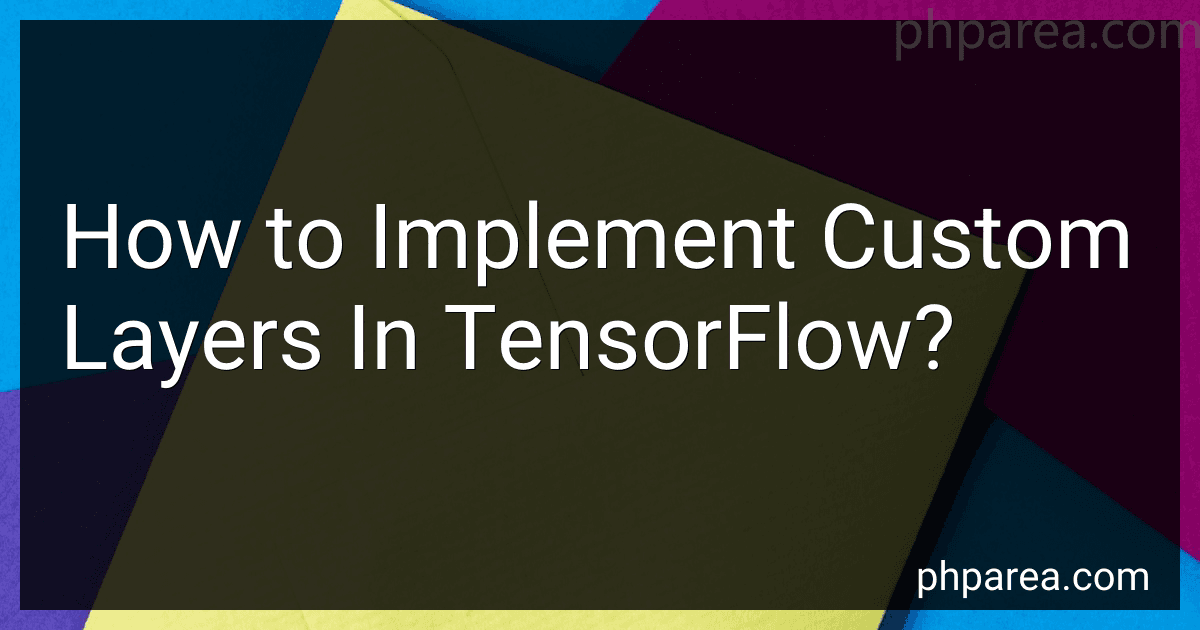Posts (page 101)
-
 13 min readSecuring a WordPress website is crucial to protect it from potential threats and ensure its smooth operation. Here are some essential measures to consider:Use strong login credentials: Create a unique and complex username and password for your WordPress admin account. Avoid using common usernames like "admin" or simple passwords. Update WordPress regularly: Ensure that your WordPress installation, themes, and plugins are up to date.
13 min readSecuring a WordPress website is crucial to protect it from potential threats and ensure its smooth operation. Here are some essential measures to consider:Use strong login credentials: Create a unique and complex username and password for your WordPress admin account. Avoid using common usernames like "admin" or simple passwords. Update WordPress regularly: Ensure that your WordPress installation, themes, and plugins are up to date.
-
 12 min readTransfer learning is a technique in machine learning where knowledge learned from one task is applied to another related task. It is particularly useful when working with limited data or computational resources. TensorFlow Hub is a library that allows you to incorporate pre-trained models and modules into your TensorFlow models easily.
12 min readTransfer learning is a technique in machine learning where knowledge learned from one task is applied to another related task. It is particularly useful when working with limited data or computational resources. TensorFlow Hub is a library that allows you to incorporate pre-trained models and modules into your TensorFlow models easily.
-
 7 min readTo generate a reference number using PHP, you can follow these steps:Start by defining a function or a piece of code that will generate the reference number. Let's call this function "generateReferenceNumber()". Determine the format or structure of the reference number you want to generate. It could be alphanumeric or numeric, with a specific length or pattern.
7 min readTo generate a reference number using PHP, you can follow these steps:Start by defining a function or a piece of code that will generate the reference number. Let's call this function "generateReferenceNumber()". Determine the format or structure of the reference number you want to generate. It could be alphanumeric or numeric, with a specific length or pattern.
-
 20 min readWhen you are using WordPress, you may encounter various errors that can affect the functionality and appearance of your website. Here is a brief guide on troubleshooting common WordPress errors:Memory Exhausted Error: This error occurs when WordPress exceeds the allocated memory limit. To fix this, you can increase the memory limit by modifying the wp-config.php file or the php.ini file.
20 min readWhen you are using WordPress, you may encounter various errors that can affect the functionality and appearance of your website. Here is a brief guide on troubleshooting common WordPress errors:Memory Exhausted Error: This error occurs when WordPress exceeds the allocated memory limit. To fix this, you can increase the memory limit by modifying the wp-config.php file or the php.ini file.
-
 11 min readHandling imbalanced datasets in TensorFlow is crucial to prevent biased models and achieve better performance in machine learning tasks. There are several approaches to tackle this issue:Data Resampling: Resampling techniques involve modifying the existing dataset to create balance between minority and majority classes. Two common methods are oversampling and undersampling.
11 min readHandling imbalanced datasets in TensorFlow is crucial to prevent biased models and achieve better performance in machine learning tasks. There are several approaches to tackle this issue:Data Resampling: Resampling techniques involve modifying the existing dataset to create balance between minority and majority classes. Two common methods are oversampling and undersampling.
-
 14 min readBacking up and restoring a WordPress site is crucial for safeguarding your website's data and ensuring its uninterrupted operation. Below are the steps to create a backup and restore your WordPress site:Backing up a WordPress Site:Choose a backup method: WordPress backup plugins like UpdraftPlus, BackWPup, or manual backups with cPanel or FTP can be used.Install and activate your preferred plugin (if using one).
14 min readBacking up and restoring a WordPress site is crucial for safeguarding your website's data and ensuring its uninterrupted operation. Below are the steps to create a backup and restore your WordPress site:Backing up a WordPress Site:Choose a backup method: WordPress backup plugins like UpdraftPlus, BackWPup, or manual backups with cPanel or FTP can be used.Install and activate your preferred plugin (if using one).
-
 5 min readTo download images with AJAX in PHP, you can follow these steps:Set up your HTML file: Include the necessary JavaScript libraries, such as jQuery, in the head section of your HTML file. Create an HTML form with an input field for the image URL or filename and a submit button. Create the PHP file: Create a new PHP file that will handle the AJAX request. Retrieve the image URL or filename sent via the AJAX request using the $_POST superglobal.
5 min readTo download images with AJAX in PHP, you can follow these steps:Set up your HTML file: Include the necessary JavaScript libraries, such as jQuery, in the head section of your HTML file. Create an HTML form with an input field for the image URL or filename and a submit button. Create the PHP file: Create a new PHP file that will handle the AJAX request. Retrieve the image URL or filename sent via the AJAX request using the $_POST superglobal.
-
 11 min readTo distribute training across multiple GPUs in TensorFlow, you can follow these steps:Import the required libraries: Import the necessary TensorFlow libraries and other dependencies. Define the Model: Define your model using TensorFlow's API, such as tf.keras. Enable GPU growth: Enable GPU growth to dynamically allocate memory when needed. This can be done with the following code snippet: import tensorflow as tf gpus = tf.config.experimental.
11 min readTo distribute training across multiple GPUs in TensorFlow, you can follow these steps:Import the required libraries: Import the necessary TensorFlow libraries and other dependencies. Define the Model: Define your model using TensorFlow's API, such as tf.keras. Enable GPU growth: Enable GPU growth to dynamically allocate memory when needed. This can be done with the following code snippet: import tensorflow as tf gpus = tf.config.experimental.
-
 7 min readIn TensorFlow, you can implement custom layers to extend the functionality of the existing layers or to create your own neural network layers. Custom layers allow you to define complex operations, handle non-standard data types, or implement specialized network architectures.To implement a custom layer in TensorFlow, you need to create a new class that subclasses the base class tf.keras.layers.Layer. This class represents your custom layer and contains the functionality of the layer.
7 min readIn TensorFlow, you can implement custom layers to extend the functionality of the existing layers or to create your own neural network layers. Custom layers allow you to define complex operations, handle non-standard data types, or implement specialized network architectures.To implement a custom layer in TensorFlow, you need to create a new class that subclasses the base class tf.keras.layers.Layer. This class represents your custom layer and contains the functionality of the layer.
-
 16 min readCreating a responsive design in WordPress involves making your website layout and elements adjust and adapt to different screen sizes and devices. Here are the main aspects to consider:Use a Responsive Theme: Start by choosing or developing a responsive WordPress theme. A responsive theme is designed to automatically adjust the layout and elements based on the device accessing the website. Responsive Images: Optimize your images for different screen sizes.
16 min readCreating a responsive design in WordPress involves making your website layout and elements adjust and adapt to different screen sizes and devices. Here are the main aspects to consider:Use a Responsive Theme: Start by choosing or developing a responsive WordPress theme. A responsive theme is designed to automatically adjust the layout and elements based on the device accessing the website. Responsive Images: Optimize your images for different screen sizes.
-
 6 min readTo use the Facebook PHP SDK in Symfony, you need to follow these steps:Install the Facebook PHP SDK library using Composer. Open your terminal or command prompt and navigate to your Symfony project directory. Run the following command: composer require facebook/graph-sdk This will download and install the Facebook PHP SDK library into your project. Create a new Facebook service in Symfony. Open your config/services.
6 min readTo use the Facebook PHP SDK in Symfony, you need to follow these steps:Install the Facebook PHP SDK library using Composer. Open your terminal or command prompt and navigate to your Symfony project directory. Run the following command: composer require facebook/graph-sdk This will download and install the Facebook PHP SDK library into your project. Create a new Facebook service in Symfony. Open your config/services.
-
 9 min readHyperparameter tuning is a crucial step in training machine learning models, including those built using TensorFlow. It involves finding the best values for hyperparameters to optimize the model's performance. TensorFlow provides several approaches for performing hyperparameter tuning, and here is an overview of the process:Define a set of hyperparameters: Start by defining the hyperparameters you want to tune.
9 min readHyperparameter tuning is a crucial step in training machine learning models, including those built using TensorFlow. It involves finding the best values for hyperparameters to optimize the model's performance. TensorFlow provides several approaches for performing hyperparameter tuning, and here is an overview of the process:Define a set of hyperparameters: Start by defining the hyperparameters you want to tune.